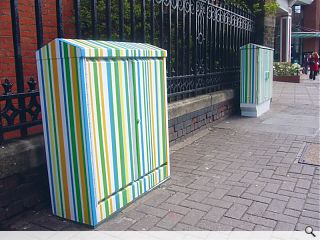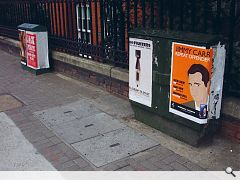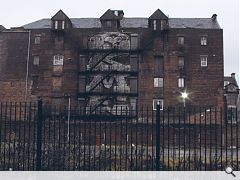Ghetto’s blasted
7 Oct 2010
Much attention has been lavished upon our city centres in the past few years, but with a resulting scaling back of budgets, scale and scope of our regeneration efforts might the time now be ripe for a fresh look at our secondary spaces? Can increasing homegenisation of our built environments be confronted through acceptance of counter culture influence on our cities? Street art, graffiti, Banksy… how do we accommodate the individual in places designed for everyone? Urban Realm spoke to neighbourhood art and design charity Urban Eye to find out.
Lanes, back alleys, courts and pends are hallmarks of Victorian and Mediaeval planning and their later post war successors but have traditionally been neglected as mere utilitarian service bays that serve as smoking haunts for skiving staff by day and as a warren of illicit activity by night. Improvements in lighting technology, sewerage, security and transport can divorce this perception from reality however, evidenced by a number of pioneering approaches which eschew the conventional solution of simply painting over scrawled tags and drawings, which simply clear the decks for the next wave of vandalism, by covering such surfaces in brightly coloured art installations using mosaics, ceramic tiles and TRIO cladding.Urban Eye’s Miles Watson, who is spearheading a campaign to revive downtrodden streets with considered scaleable interventions, said: “We’re very interested in neglected areas in cities which no-one was making an effort to improve, they simply weren’t being maintained. An example would be underneath rail bridges. Tube companies maintained the structure, council handled lighting underneath but that was it. The whole physical environment was depressing, dirty and underlit creating an inhospitable environment with flyposting, people urinating in corners, throwing out rubbish, muggings, pigeon guano… if I was a predator wanting to rob people that would be a great environment for me but these spaces can be addressed and it doesn’t require some enormous amount of money to do that. It just requires intelligence and an understanding of what can be done to minimise seclusion. The more footfall there is the healthier the environment.”
Urban Eye cite surveys which showed 61% of respondents would consider taking a cab rather than walk or cycle through graffiti daubed locales and a hefty 83% would seek to avoid streets that were perceived to be neglected. So why aren’t these techniques being embraced more fully? Watson observed: “There’s something bleak about seeing shops boarded up. Many people will initially say ‘I’ll just get on with it’, or ‘I’ll put up with it’ but this is not a great outcome and betrays declining expectations. That’s why people appreciate our mosaics because a lot of effort goes into them, it only takes a few minutes to spray a wall with graffiti with very little thought but to put in a proper artistic intervention takes a lot longer and creative energy and people respond to that. That is why a lot of the projects we’ve done haven’t been destroyed or damaged.”
Addressing the thorny issue of where the line can be drawn between graffiti and vandalism, Watson said: “It’s a very contentious issue. I would say there is a very clear line, Banksy is the exception who proves the rule he’s got some real imagination and creative intelligence but I would say about 99% of remaining graffiti artists are not creative and are in fact retreading a kind of second hand 1980’s American culture. It hasn’t moved forward one jot in nearly 30 years. I wouldn’t feel that strongly about it either way for the fact that most people, once you get away from the fashionable pressure to like it which is surprisingly prevalent once you dig down, most people don’t like it and find it flattening and intrusive and creates an atmosphere and environment of neglect, it makes people think that no-one cares and that the public fiefdom is abused.”
It is perhaps ironic that counter culture influences have become as internationally standardised as the multinational corporations which reside at the opposite end of the social spectra. But its effect is equally as deadening as Watson points out: “Globalisation is very disappointing, visually, spiritually… in every sense. I’d like to see a world that moves away from that but I think we’re stuck with it for a while. Even Venice has a McDonalds, there’s no respect for any other cultural manifestation going on, everything gets ironed out in the name of big business and while I’ve got nothing against big business I think that a very unfortunate side effect of it is this homegenisation of our town centres. It’s a very pressing problem in the west at the moment because we have a very individualistic society, the trouble is if you follow that to it’s conclusion you end up with anarchy and in anarchy no-ones happy. So we need a social realm and code or we’ll end up with a very fragmented society and things that don’t really work properly and I think we’re quite close to that! I’m not advocating any state run interventions, I think that would be awful as well, but we need a civic sense and that involves people working to the greater good not just the individual good. Real creativity comes out of that but graffiti is very conformist in a way, people are slavishly copying fashion without really doing very much.”
Citing an alternative approach which has met with real success Watson outlined a key project in London: “I’ve worked with local residents on Portobello Road to protect antique shops, second hand shops and stylish individual retailers. There was a fear that the space was going to become colonised by big chain stores and become just like every other High Street in the country. The Council said we have the power to stop change of use but not to stop one retailer taking over from another one, but that was argued quite strongly by the residents and business holders and the council intervened to stop that happening. Ultimately that kills the golden goose because people come from all over the world to visit Portobello Market, but they won’t if it’s just another Starbucks. It’s very hard for businesses to resist retailers particularly in the current economy.”
The broken window theory, first coined in a 1982 article by social scientists James Wilson and George Kelling, is an idea which still resonates with those involved in the built environment today and one which Watson wholeheartedly concurs. “I’ve watched it happen. Some local authorities are too lazy, or don’t have the resources if one tag appears then another will appear and it exponentially increases. Graffiti artists are sheep they’re not people with original ideas, making that first move requires more.
Crucial to any successful solution, you’d have thought, was lighting. But Watson points out that, incredibly, no scientific studies to find the optimal standard of street lighting have been carried out. Pointing out that traditional sodium lighting in leafy residential streets is “fine” and “quite friendly.” Watson observes that they tend to come unstuck in large hostile estates or imposing structures and bridges where its use can be “terrible.” “It creates a very unpleasant and dangerous feeling in the environment and that’s to do with the characteristic of the light and the degree to which one can see what’s going on. Local authorities prefer them because they are low maintenance but you get very low colour rendering.” However Watson adds: “Harsh white lights on the other hand create another kind of atmosphere which is almost worse. It’s a cold almost prison kind of lighting. Some LED lights for security and energy saving need to be handled with care because the risk is we end up with an equally cold and threatening environment. When the level of lighting is ramped up too far it creates a very stark environment. Good civic design is about responding to context, not the general fix. Developing four or five approaches is better than one roll out across a city.
“I don’t like our culture of surveillance and I’m not a great fan of CCTV, it’s a little too much Big Brother in the Orwellian sense, who’s watching, what’s the response time? I think its just data being collected; I’d like to see data on crimes being cleared up after that and whether crimes would have been prevented through police on the beat rather than just watching in a comfortable office somewhere. It’s trusting that we’re going to have the same kind of moderately liberal government in the future and I think there is so much being watched that if a government with much more oppressive purposes got into power they would have access to much too much information on all of us. A negotiated environment is better to one that is over regulated because it places responsibility in the hands of people who are well able to live up to that. Most people respond well to being treated as responsible citizens, if you treat them as dangerous children that need to be looked after it infantilises people.”
In a world of increasing “celebrity” one famous figure continues to retain an air of mystery. Banksy the world’s best known street artist has striven to maintain an air of mystery that elevates his work beyond the individual. Perhaps if we all took a leaf out of Banksy’s book our cities would be a lot more individual too. Glasgow has experimented with the Radiance light festival, an opportunity to put many of the cities forgotten and derelict spaces in a new light encouraging many families to the city after hours, starkly illuminating the potential that exists. But as a biennial event its impact is fleeting. Perhaps the city could learn something from its great rival, Edinburgh, in maximising the value of its forgotten streets by mimicking the tourist draw of Reekie’s vennels, closes and subterranean streets.
|
|
Read next: Sins of Saint James
Read previous: John o’Grots
Back to October 2010
Browse Features Archive
Search
News
For more news from the industry visit our News section.
Features & Reports
For more information from the industry visit our Features & Reports section.





